1 isShutdown()方法
public boolean isShutdown()方法的作用是判断线程池是否已经关闭
public class Run1 {
public static void main(String[] args) {
Runnable runnable = new Runnable() {
@Override
public void run() {
try {
System.out.println("开始: " + Thread.currentThread().getName());
Thread.sleep(1000);
System.out.println("结束: " + Thread.currentThread().getName());
}catch (InterruptedException e){
e.printStackTrace();
}
}
};
ThreadPoolExecutor pool = new ThreadPoolExecutor(2,2,Integer.MAX_VALUE, TimeUnit.SECONDS,new LinkedBlockingDeque<>());
pool.execute(runnable);
System.out.println("A = " + pool.isShutdown());
pool.shutdown();
System.out.println("B = " + pool.isShutdown());
}
}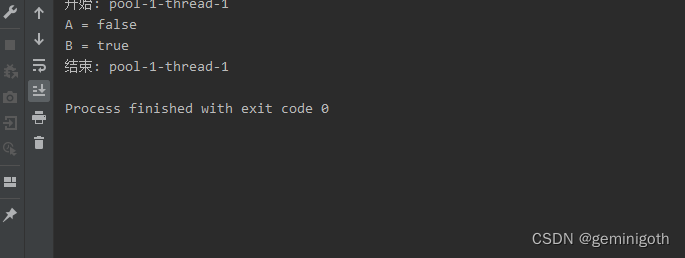
由运行结果可知,只要调用了shutdown()方法,isShutdown()方法的返回值就是true。
2 isTerminating()和isTerminated()方法
public boolean isTerminating()方法:如果此执行程序处于在shutdown或shutdownNow之后且正在终止但尚未完全终止的过程中,也就是还有任务在执行,则返回true。此方法可以比喻成门是否正在关闭。
public boolean isTerminated()方法:如果关闭后所有任务都已完成,则返回true。此方法可以比喻成门是否已经关闭。
shutdown或shutdownNow方法的功能是发出一个关闭线程池的命令,isShutdown方法用于判断关闭线程池的命令发出或未发出。 isTerminating方法用于判断线程池是否正在关闭中,isTerminated方法判断线程池是否已经关闭了。
public class MyRunnable implements Runnable{
@Override
public void run() {
try {
System.out.println(Thread.currentThread().getName()+"begin: "+ Utils.data(System.currentTimeMillis()));
Thread.sleep(2000);
System.out.println(Thread.currentThread().getName()+"end: "+ Utils.data(System.currentTimeMillis()));
}catch (InterruptedException e){
e.printStackTrace();
}
}
}public class Test {
public static void main(String[] args) throws InterruptedException {
MyRunnable runnable = new MyRunnable();
ThreadPoolExecutor pool = new ThreadPoolExecutor(2,99999,99999, TimeUnit.SECONDS,new LinkedBlockingDeque<>());
pool.execute(runnable);
pool.execute(runnable);
pool.execute(runnable);
pool.execute(runnable);
System.out.println(pool.isTerminating() + " " + pool.isTerminated());
pool.shutdown();
Thread.sleep(1000);
System.out.println(pool.isTerminating() + " " + pool.isTerminated());
Thread.sleep(1000);
System.out.println(pool.isTerminating() + " " + pool.isTerminated());
Thread.sleep(1000);
System.out.println(pool.isTerminating() + " " + pool.isTerminated());
Thread.sleep(1000);
System.out.println(pool.isTerminating() + " " + pool.isTerminated());
Thread.sleep(1000);
System.out.println(pool.isTerminating() + " " + pool.isTerminated());
}
}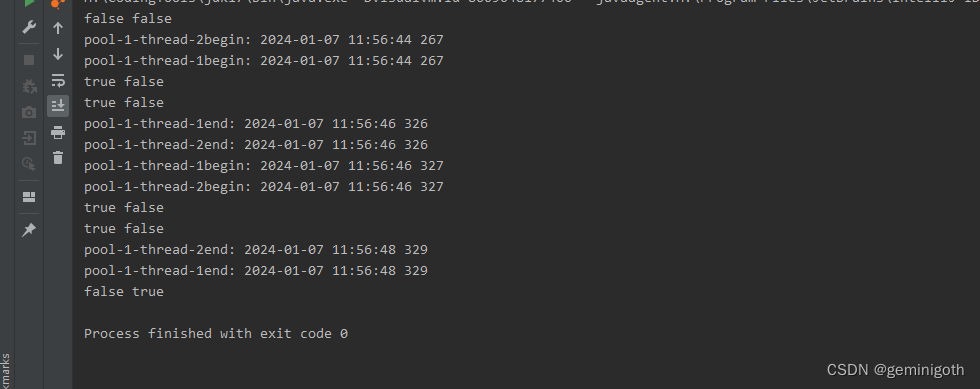
3 awaitTermination(long timeout, TimeUnit unit)
public boolean awaitTermination(long timeout, TimeUnit unit)方法:查看在指定的时间内,线程池是否已经终止工作,也就是“最多”等待多少时间后去判断线程池是否已经终止工作。如果在指定的时间之内,线程池销毁会导致该方法不再阻塞,而超过timeout时间也会导致该方法不再阻塞。此方法的使用需要shutdown()方法的配合。
public class MyRunnable1 implements Runnable{
@Override
public void run() {
try {
System.out.println(Thread.currentThread().getName() + " " + Utils.data(System.currentTimeMillis()));
Thread.sleep(4000);
System.out.println(Thread.currentThread().getName() + " " + Utils.data(System.currentTimeMillis()));
}catch (InterruptedException e){
e.printStackTrace();
}
}
}public class Test1 {
public static void main(String[] args) throws InterruptedException {
MyRunnable1 runnable1 = new MyRunnable1();
ThreadPoolExecutor pool = new ThreadPoolExecutor(2,99999,9999L, TimeUnit.SECONDS,new LinkedBlockingQueue<>());
pool.execute(runnable1);
System.out.println("main开始:" + Utils.data(System.currentTimeMillis()));
System.out.println(pool.awaitTermination(10,TimeUnit.SECONDS));
System.out.println("main结束:" + Utils.data(System.currentTimeMillis()));
}
}

从控制台可以看出,main开始到main结束需要10秒,因为main线程并未销毁,所以 awaitTermination方法需要阻塞10秒。打印false的原因是未对线程池执行shutdown方法。如果对线程池执行shutdown方法,在运行时间上会有什么效果呢?
public class Test2 {
public static void main(String[] args) throws InterruptedException {
MyRunnable1 runnable1 = new MyRunnable1();
ThreadPoolExecutor pool = new ThreadPoolExecutor(2,99999,9999L, TimeUnit.SECONDS,new LinkedBlockingQueue<>());
pool.execute(runnable1);
pool.shutdown();
System.out.println("main开始:" + Utils.data(System.currentTimeMillis()));
System.out.println(pool.awaitTermination(10,TimeUnit.SECONDS));
System.out.println("main结束:" + Utils.data(System.currentTimeMillis()));
}
}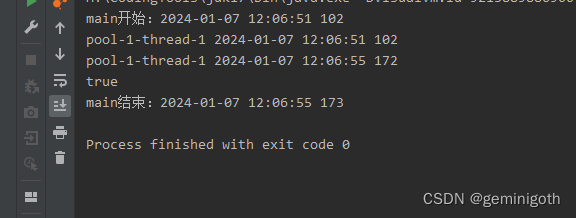
可以看出,main开始和mian结束之间耗时4秒,因为4秒后线程池销毁了,导致 awaitTermination方法取消阻塞。
4 set/getRejectedExceptionHandler()方法
public void setRejectedExecutionHandler(RejectedExecutionHandler handler)和
public RejectedExecutionHandler getRejectedExecutionHandler()方法的作用是可以处理任务被拒绝执行时的行为。
public class MyRunnable1 implements Runnable{
private String username;
public MyRunnable1(String username) {
this.username = username;
}
public String getUsername() {
return username;
}
public void setUsername(String username) {
this.username = username;
}
@Override
public void run() {
try {
System.out.println(Thread.currentThread().getName()+ "开始时间 = " + Utils.data(System.currentTimeMillis()));
Thread.sleep(4000);
System.out.println(Thread.currentThread().getName()+ "结束时间 = " + Utils.data(System.currentTimeMillis()));
}catch (InterruptedException e){
e.printStackTrace();
}
}
}public class Run1 {
public static void main(String[] args) {
MyRunnable1 myRunnable1 = new MyRunnable1("a1");
MyRunnable1 myRunnable2 = new MyRunnable1("a2");
MyRunnable1 myRunnable3 = new MyRunnable1("a3");
MyRunnable1 myRunnable4 = new MyRunnable1("a4");
ThreadPoolExecutor pool = new ThreadPoolExecutor(2,3,999L, TimeUnit.SECONDS,new SynchronousQueue<>());
pool.execute(myRunnable1);
pool.execute(myRunnable2);
pool.execute(myRunnable3);
pool.execute(myRunnable4);
}
}
控制台打印的信息说明 MyRunnable1 myRunnable4 = new MyRunnable1("a4");任务被拒绝执行,在出现这样的异常时可以自定义拒绝执行任务的行为。创建MyRejectedExecutionHandler.java类。
public class MyRejectedExecutionHandler implements RejectedExecutionHandler {
@Override
public void rejectedExecution(Runnable r, ThreadPoolExecutor executor) {
System.out.println(((MyRunnable1) r).getUsername() + "被拒绝执行");
}
}
public class Run2 {
public static void main(String[] args) {
MyRunnable1 myRunnable1 = new MyRunnable1("a1");
MyRunnable1 myRunnable2 = new MyRunnable1("a2");
MyRunnable1 myRunnable3 = new MyRunnable1("a3");
MyRunnable1 myRunnable4 = new MyRunnable1("a4");
ThreadPoolExecutor pool = new ThreadPoolExecutor(2,3,999L, TimeUnit.SECONDS,new SynchronousQueue<>());
pool.setRejectedExecutionHandler(new MyRejectedExecutionHandler());
pool.execute(myRunnable1);
pool.execute(myRunnable2);
pool.execute(myRunnable3);
pool.execute(myRunnable4);
pool.shutdown();
}
}

5 allowsCoreThreadTimeOut()和allowCoreThreadTimeOut(bool)方法
allowsCoreThreadTimeOut(true)可使核心池中的空闲线程具有超时销毁的特性。其中,public boolean allowsCoreThreadTimeOut() 方法的作用是判断是否具有这个特性。
public void allowCoreThreadTimeOut(boolean value)方法的作用是设置是否有这个特性。
public class MyRunnable implements Runnable{
@Override
public void run() {
System.out.println(Thread.currentThread() + "开始:" + Utils.data(System.currentTimeMillis()));
System.out.println(Thread.currentThread() + "结束:" + Utils.data(System.currentTimeMillis()));
}
}public class Run1 {
public static void main(String[] args) throws InterruptedException {
ThreadPoolExecutor pool = new ThreadPoolExecutor(4,5,5, TimeUnit.SECONDS,new SynchronousQueue<>());
System.out.println(pool.allowsCoreThreadTimeOut());
for (int i = 0; i < 4; i++) {
MyRunnable myRunnable = new MyRunnable();
pool.execute(myRunnable);
}
Thread.sleep(8000);
System.out.println(pool.getPoolSize());
}
}
创建Run2.java类
public class Run2 {
public static void main(String[] args) throws InterruptedException {
ThreadPoolExecutor pool = new ThreadPoolExecutor(4,5,5, TimeUnit.SECONDS,new SynchronousQueue<>());
pool.allowCoreThreadTimeOut(true);
System.out.println(pool.allowsCoreThreadTimeOut());
for (int i = 0; i < 4; i++) {
MyRunnable myRunnable = new MyRunnable();
pool.execute(myRunnable);
}
Thread.sleep(8000);
System.out.println(pool.getPoolSize());
}
} 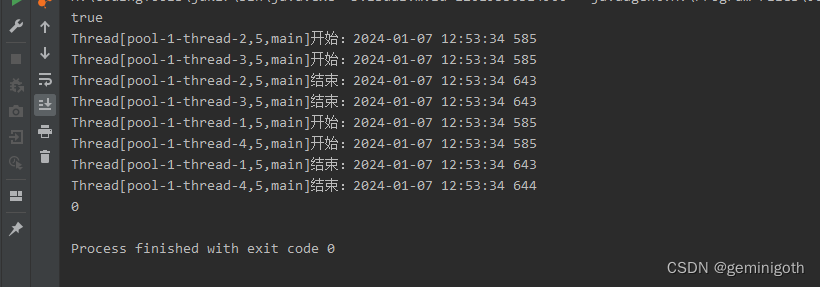
6 prestartCoreThread()和prestartAllCoreThreads()方法
在实例化ThreadPoolExecutor类后,线程池并没有核心线程,除非执行execute()方法,但是在不执行execute()方法时也可以通过执行prestartCoreThread()和prestartAllCoreThreads()方法来创建核心线程。
public boolean prestartCoreThread()方法的作用是每调用一次就创建一个核心线程并使它变成启动状态,返回值类型为boolean,代表是否创建成功。
public int prestartAllCoreThreads()方法的作用是同时启动全部核心线程,返回值是启动核心线程的数量。
public class Run1 {
public static void main(String[] args) {
ThreadPoolExecutor pools = new ThreadPoolExecutor(4,8,5, TimeUnit.SECONDS,new LinkedBlockingQueue<>());
System.out.println("线程池中的线程数a= " + pools.getPoolSize());
System.out.println("Z1 = " + pools.prestartCoreThread());
System.out.println("线程池中的线程数a= " + pools.getPoolSize());
System.out.println("Z2 = " + pools.prestartCoreThread());
System.out.println("线程池中的线程数a= " + pools.getPoolSize());
System.out.println("Z3 = " + pools.prestartCoreThread());
System.out.println("线程池中的线程数a= " + pools.getPoolSize());
System.out.println("Z4 = " + pools.prestartCoreThread());
System.out.println("线程池中的线程数a= " + pools.getPoolSize());
System.out.println("Z5 = " + pools.prestartCoreThread());
System.out.println("线程池中的线程数a= " + pools.getPoolSize());
System.out.println("Z6 = " + pools.prestartCoreThread());
}
} 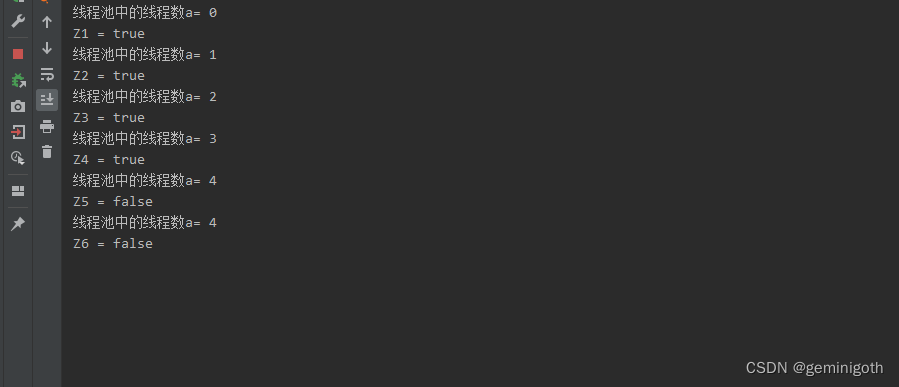
最后连续打印了2个false代表核心池中的线程数量已经到了最大值,是4。不能再创建新的核心池中的线程了。
创建Run2.java类。
public class Run2 {
public static void main(String[] args) {
ThreadPoolExecutor pools = new ThreadPoolExecutor(4,8,5, TimeUnit.SECONDS,new LinkedBlockingQueue<>());
System.out.println("线程池中的线程数a= " + pools.getPoolSize());
System.out.println("Z1 = " + pools.prestartAllCoreThreads());
System.out.println("线程池中的线程数a= " + pools.getPoolSize());
System.out.println();
System.out.println("Z2 = " + pools.prestartAllCoreThreads());
System.out.println("线程池中的线程数a= " + pools.getPoolSize());
}
}
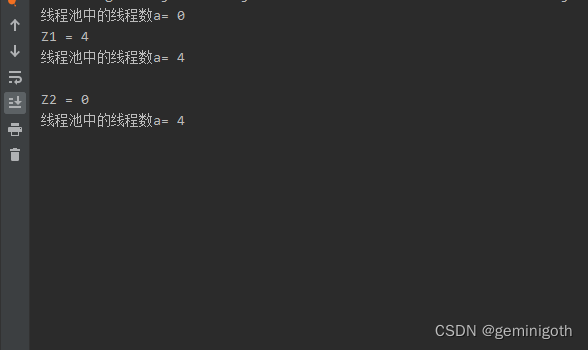
打印信息Z2 = 0,说明核心池中的线程已满,不需要创建新的核心池中的线程。























 4万+
4万+











 被折叠的 条评论
为什么被折叠?
被折叠的 条评论
为什么被折叠?










